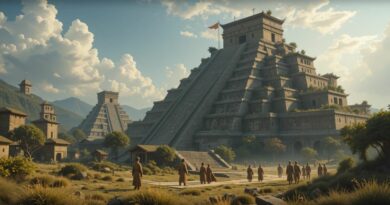The Eleusinian Mysteries: Ancient Greece’s Most Sacred Secrets
In the dusty hills fourteen miles west of Athens, where olive groves give way to sacred ground, lies the archaeological site of Eleusis—once home to the ancient world’s most profound spiritual transformation. For nearly two millennia, from around 1500 BCE until 392 CE, pilgrims journeyed here to participate in the Eleusinian Mysteries, rites so sacred that revealing their secrets meant death.
What transpired within the walls of the Telesterion, Eleusis’s great hall of initiation, remains largely unknown. Yet the transformative power of these ceremonies was so profound that ancient luminaries including Plato, Cicero, and the emperor Marcus Aurelius counted themselves among the initiated. Cicero himself declared that Athens had given humanity nothing finer than these mysteries, which taught mortals “how to live joyfully and die with hope.”
The Divine Drama of Demeter and Persephone
At the heart of the Eleusinian Mysteries lay one of Greek mythology’s most poignant tales: the abduction of Persephone by Hades, god of the underworld. According to the Homeric Hymn to Demeter, composed around the seventh century BCE, Persephone was gathering flowers in a meadow when the earth split open and Hades emerged to seize her as his bride.
Demeter, the goddess of grain and harvest, searched the world for her missing daughter. In her grief, she withdrew her divine blessing from the earth, causing crops to fail and threatening humanity with starvation. Eventually, Zeus intervened, but Persephone had already eaten pomegranate seeds in the underworld, binding her to spend part of each year with Hades.
This mythological framework provided more than entertainment—it offered the ancient Greeks a powerful metaphor for the agricultural cycle and, more significantly, the promise of life beyond death. The story explained why winter brought barrenness whilst spring brought renewal, but it also hinted at something more profound: the possibility of spiritual rebirth through ritual death and resurrection.
A Journey Through the Sacred Calendar
The Eleusinian Mysteries unfolded in two distinct phases throughout the year. The Lesser Mysteries, held in early spring during the month of Anthesterion, served as a preliminary initiation in Athens. These rites, conducted at the Eleusinion temple beneath the Acropolis, prepared candidates—known as mystai—for the greater revelations to come.
The Greater Mysteries began each September with elaborate processions from Athens to Eleusis. Thousands of pilgrims, from slaves to emperors, walked the Sacred Way, carrying sacred objects and chanting hymns. The procession paused at bridges where masked figures hurled insults at the participants—a ritual humiliation designed to break down social barriers and ego before the sacred encounter.
The climax occurred in the Telesterion, a vast columned hall capable of accommodating thousands. Here, in absolute darkness, the initiates experienced what the Greeks called the epopteia—the “seeing” that transformed their understanding of life and death. Classical scholar Walter Burkert, one of the twentieth century’s foremost experts on ancient Greek religion, described this moment as “the most important religious experience of the ancient world.”
The Kykeon Controversy: Ancient Chemistry or Divine Vision?
Perhaps no aspect of the Eleusinian Mysteries has generated more scholarly debate than the role of kykeon, a ritual drink consumed by initiates. Ancient sources describe it as a mixture of barley, water, and mint, yet this simple recipe seems insufficient to explain the profound visions reported by participants.
In 1978, a groundbreaking book titled “The Road to Eleusis” proposed a revolutionary theory. Authors R. Gordon Wasson, Albert Hofmann (the chemist who first synthesised LSD), and Carl Ruck argued that the barley used in kykeon was infected with ergot fungus, producing naturally occurring psychoactive compounds.
Albert Hoffmann confirmed that the ergot of barley would contain two psychoactive alkaloids, ergonovine and lysergic acid amide, both soluble in water, making it theoretically possible to create a hallucinogenic solution. Recent scholarly consensus suggests that the drink kykeon likely contained ergot fungus and produced psychedelic effects when consumed.
This theory remains contentious. Critics argue that ergot contamination would have been difficult to control consistently over two millennia, and that the profound psychological impact of the mysteries might be better explained by ritual theatre, sensory deprivation, and group psychology rather than pharmacological intervention.
Archaeological Whispers from Sacred Ground
Modern archaeology has revealed tantalising glimpses of what occurred at Eleusis, though the site’s secrets remain largely intact. Excavations have uncovered the foundations of the great Telesterion, with its forest of columns and tiered seating carved into bedrock. The hall’s acoustics were carefully designed to amplify whispered words and create an atmosphere of otherworldly mystery.
Archaeological evidence suggests the ceremonies involved dramatic re-enactments of the Persephone myth, complete with special effects. Ancient sources mention the sudden appearance of brilliant light in the darkened hall, the display of sacred objects, and the emergence of figures representing the divine family of Demeter, Persephone, and the culture hero Triptolemus.
The British Museum houses several votive reliefs from Eleusis showing Triptolemus receiving grain from Demeter—images that may provide clues about the visual elements of the initiation. These artistic representations consistently emphasise themes of agricultural abundance and divine blessing, reinforcing the connection between earthly fertility and spiritual transformation.
The Promise of Blessed Afterlife
What made the Eleusinian Mysteries so compelling to ancient participants was their promise of a transformed afterlife. Unlike the gloomy underworld described in mainstream Greek religion, initiates were assured of a blessed existence after death. The poet Pindar wrote that those who had “seen these rites before going beneath the earth” would have “life” in the afterlife, whilst others would suffer “all manner of evil.”
This promise of personal salvation represented a significant departure from traditional Greek religious thought, which generally offered little comfort regarding the fate of the soul. The mysteries provided what scholar Carl Kerenyi called “the archetypal experience of individual transformation through contact with the divine feminine.”
The psychological impact of this transformation appears to have been profound and lasting. Initiates often spoke of losing their fear of death and gaining a deeper appreciation for life’s sacred dimensions. The playwright Sophocles, himself an initiate, wrote: “Thrice blessed are those mortals who, having seen these rites, depart for Hades; for them alone there is life; for others all is misery.”
The Mysteries’ Influence on Western Spirituality
The influence of the Eleusinian Mysteries extended far beyond classical antiquity. Early Christian theologians borrowed extensively from mystery religion terminology and concepts. The Christian emphasis on death and resurrection, the promise of eternal life, and the use of sacred communal meals all show striking parallels to Eleusinian practice.
Some scholars argue that the mysteries provided a template for the development of Christian sacramental theology. The transformation of bread and wine in the Eucharist echoes the sacred consumption of kykeon, whilst the Christian concept of being “born again” mirrors the Eleusinian promise of spiritual rebirth through ritual death.
Modern psychological research has also found relevance in the Eleusinian model. Studies of psychedelic-assisted therapy have noted similarities between reported mystical experiences and ancient descriptions of mystery initiation. Researchers at institutions like Johns Hopkins University and UC Berkeley have begun exploring whether contemporary therapeutic practices might learn from ancient wisdom traditions.
The End of an Era
The Eleusinian Mysteries survived the rise of Rome, adapting to imperial patronage whilst maintaining their essential character. Emperors including Augustus, Hadrian, and Marcus Aurelius underwent initiation, testament to the rites’ continued relevance in the classical world.
The end came not through persecution but through cultural transformation. As Christianity gained imperial favour in the fourth century CE, traditional mystery religions fell into decline. The final blow arrived in 392 CE when Emperor Theodosius I issued edicts closing all pagan temples. The great Telesterion fell silent, its secrets dying with the last generation of initiates.
Yet the legacy of Eleusis endures. In an age increasingly interested in consciousness, spirituality, and the nature of transformative experience, the Eleusinian Mysteries continue to fascinate researchers, spiritual seekers, and anyone drawn to the profound questions of human existence. They remind us that the search for meaning, the hope for transformation, and the promise of transcendence are as old as civilisation itself.
Rediscovering Ancient Wisdom
Today, as interest in psychedelic research and consciousness studies grows, the Eleusinian Mysteries offer a compelling historical precedent for the careful, sacred use of altered states in spiritual practice. Whether achieved through pharmacological means, ritual theatre, or pure mystical experience, the transformations reported by ancient initiates speak to fundamental human needs that transcend historical periods.
The site of Eleusis continues to yield archaeological treasures, each discovery adding another piece to the puzzle of these ancient rites. Whilst we may never fully understand what occurred in the Telesterion’s darkness, the enduring fascination with these mysteries suggests they touched something essential in the human experience—our eternal quest to understand life, death, and the possibility of transcendence.
In our contemporary search for meaning and transformation, the Eleusinian Mysteries stand as a reminder that some human longings are timeless. They invite us to consider what it might mean to approach the sacred with proper reverence, to seek transformation through encounter with mystery, and to find in ancient wisdom guidance for modern questions about consciousness, spirituality, and the deepest purposes of human existence.
The secrets of Eleusis may be lost, but their promise endures: that through sacred encounter, we might transcend the limitations of ordinary existence and discover new possibilities for human flourishing. In this sense, the Eleusinian Mysteries continue to offer their ancient gift—not knowledge to be grasped, but transformation to be experienced.
We’d like to hear your questions or comments on today’s topic!
For more articles like this one, click here.
Thought for the day:
“Love that ends is the shadow of love; true love is without beginning or end.” Hazrat Inayat Khan



